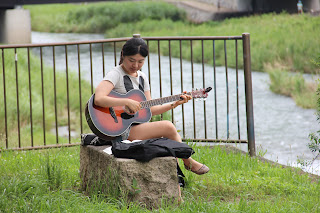* de Nederlandse tekst vind je verderop *
In my hometown Maastricht I am used to cycle to work along the river. It
is very pleasant that I can continue this habit in Kyoto where I live
close to the Kamo gama: the wild duck
river. There are two differences
however. The distance to my workplace is larger (3.5 km) and the route is far more adventurous. So it is a double change for the better.
The
Kamo River has its source in the mountains, North of Kyoto . Somewhere near the
centre the river joins with the Takano River which flows
down from the north-eastern direction. Since these mountain rivers have just
a few artificial constructions, the river
area looks natural and rather pristine.
Indeed it is a huge nature area
throughout this big city.
I start my morning ride in the North where
the bumpy narrow path goes along several waterfalls. The water
level is usually relatively low; less
than one meter in most places. But since the rainy season has started, the river is
full and the water clatters downstream. Under the first bridge I balance on a strip of 80 centimetre along a
row of zero yen houses closely watching the
doors in case the resident might come out. Soon after, the path becomes wider, so I can bike more relaxed. The riverbanks are very popular
spots for the outdoor activities like walking, running, fishing or gymnastics.
But the Kyoto residents also go to the river to play music, practice choir chants or declaim. For them this beautiful public space is an extension of
their small, thin- walled house. Nobody seems surprised, except a gajin like me (the Japanese word for
foreigner; literal meaning: alien ) who cannot resist to make pictures.
Fortunately, there is no time clock in
the institute where I work.
Please enjoy some ‘wild
duck’ impressions below.
wilde eenden
In mijn woonplaats Maastricht fiets ik altijd langs de rivier
naar mijn werk. Het is fijn dat ik dit in Kyoto kan blijven doen, want ik woon hier dicht bij de Kamo gama: de wilde eend
rivier. Maar er zijn twee belangrijke verschillen. De afstand naar mijn werk is
nu een stuk langer (het is 3,5 kilometer) en de route is avontuurlijker. Het is dubbel zo leuk dus.
De Kamo rivier begint
in de bergen
ten noorden van Kyoto. Bij het centrum van de stad komt
hij samen met de Takano rivier die
vanuit de bergen ten oosten van
de stad naar beneden stroomt . Anders dan bij de Maas zijn
er maar een paar constructies aangebracht in deze berg rivieren. Daardoor ziet het rivierengebied er heel natuurlijk en ongerept
uit. Feitelijk is het een enorm natuurgebied, dwars door deze grote stad heen.
Ik begin mijn ochtendritje
in het noorden over een hobbelig pad langs verschillende watervallen. Het
waterpeil is meestal laag; op de meeste plaatsen minder dan een meter. Maar nu
het regenseizoen is begonnen, is de rivier vol en klettert het water naar
beneden. Onder de eerste brug balanceer ik over een strook van zo’n 80 centimeter
langs een rijtje zero yen huizen. Ik
hou de deurtjes angstvallig in de gaten,
voor het geval een bewoner naar buiten
zou willen. Even later wordt het pad breder en kan ik ontspannen verder
fietsen. De oevers van de rivier
zijn heel populair voor de gebruikelijke outdoor
activiteiten zoals wandelen, hardlopen,
vissen of gymnastiek. Maar de inwoners
van Kyoto gaan ook naar de rivier om muziek te spelen, te zingen of te
declameren. Deze prachtige plek is voor
velen een verlengstuk van hun kleine, gehorige woningen. Niemand
kijkt er vreemd van op, behalve een gajin
als ik ( het Japanse woord voor buitenlander, dat letterlijk alien betekent), die het niet kan laten
foto’s te maken. Gelukkig is er geen tijdklok op het instituut waar ik werk.








Dear Jeanine,
ReplyDeleteIt is such a pleasure to read your lovely blog posts and re-discover Japan through your inspiring perspective, keen insights and precious observations. Your articles make me want to go back to Japan! Until when will you be in Kyoto? If you have a chance, it would be wonderful if you could share your findings through PechaKucha Kyoto: http://www.pecha-kucha.org/night/kyoto/7, although I'm not sure when they're going to hold their next event. PechaKucha Tokyo seems to be much more active so that could be an idea too. TEDxKyoto: http://www.tedxkyoto.com/en/events-2/ might also be a good platform to share your findings on sustainable lifestyles in Japan.
In the meantime, I'm always looking forward to your next article :-)
Warm greetings from Maastricht,
Sueli
Dear Sueli,
DeleteMany thanks for your kind words and the info about PechaKucha Kyoto and Tokyo. I checked the schedules of both locations, but unfortunately it does not fit into mine. Possibly next time? I will keep your valuable suggestion in mind.
The speakers-list however gave me an interesting picture of what currently is 'en vogue' in Japan's metropoles. Very useful for my study indeed.
Please wait to go back to Japan. In a couple of weeks I will return to Maastricht. Hope to see you there. Best regards,
Jeanine
We missed you in Sagano on 11th, but it was good to see Erik. Your photos nicely capture the informal aspects of one part of Kyoto, Kamo River, and some of its inhabitants. Your gaijin's perspective is interesting. While Kyoto's calendar is very full and traditions very clear, yet there is always room for a little experimentation, and the town's natural setting is very relaxing in spite of its large 1-million plus population.
ReplyDelete